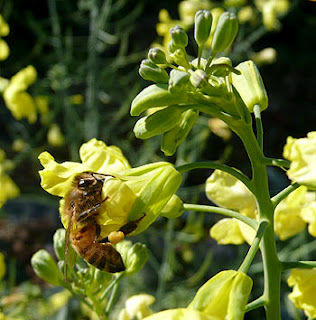Beekeeping has taken my connection to the land to a much deeper level. At this, the end of my second full season as a backyard beekeeper, I pause to appreciate the gift the bees have brought me: the gift of connection to the great wheel of life.
Over the course of the spring and summer, I am in tune with the flowers. Willow, black raspberry, apple, dandelion, black locust. Catmint, chives, wild geranium, black cohosh, echinacea. Native plants abound: sumac, white clover, alfalfa, the sweet clovers. Each day, I note what plants the bees are visiting. I read, observe, and try to find out where they are getting the bulk of their nectar and pollen. I watch excitedly as the flowers gently fold and the pollinated plants begin to set fruit.

season, broccoli . photo by Ann D. Watson
Fruit season begins: black raspberries behind the kitchen, which a month ago the bees were pollinating, are fat and juicy on the canes. Then come blackberries. The early sun and rain combined with excellent pollination have made a bumper crop. I think of how the pollinators worked the flowers which have turned into the plump, flavorful delights I now pop into my mouth. I spend hours in the patch and return with brimming baskets, my arms scratched and clothes stained purple. Two quarts make a blackberry cobbler to die for. Ten quarts go into the freezer.
Late summer has arrived. The goldenrod is beginning to bloom. Now all is dependent on weather. I check weekly to see if another honey super is needed. If it’s cloudy, I’m making my plans for taking off and extracting the honey. Goldenrod is in full bloom, a great yellow swath of color dotted with spots of mauve Joe-Pye Weed and white boneset.
The end of August comes and it’s time to take the honey off. I have few enough supers that I can afford the time to use an old fashioned, unheated knife to gently slice off the cappings in an unhurried manner. As I work, I meditate on the great wheel of the seasons that turns every day imperceptibly, gradually leading us toward the end of the summer and the long winter after that.
Aster flowers open. The warm sunny days are fewer now, and farther between. Aside from the sedum and borage still adorning my garden, this is the last major food for the bees, the last chance to store up summer’s bounty in the form of honey, to feed the colony through a long cold period without fresh food. I feel a sadness come over me, knowing that as each day comes and goes, there are fewer times when it will be warm enough for the bees to fly free in the fresh air and gather fresh nectar. They are driving the drones, now-useless consumers of precious food, out of the hive, cutting their losses, battening down the hatches. Now I can only trust that my vigilance all summer and the bounty of the land, have made the bees strong and numerous enough to keep each other warm on the coldest days and to move to their honey stores as they need to. I am grateful for the millions of flowers they have visited and their strength in fanning their wings to evaporate the water out of the honey; for their ability to make wax to cap their stores; and for the trust that once more, enough bees will survive the winter to keep their species going another season. Most of all, I am grateful for the deeper connection to the land which the bees have brought me.